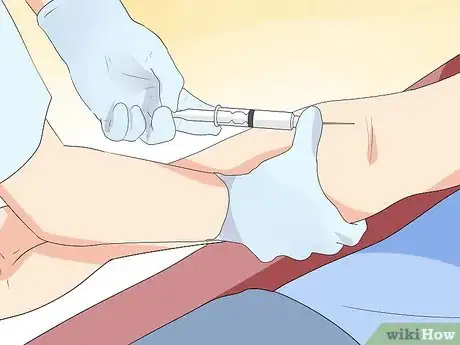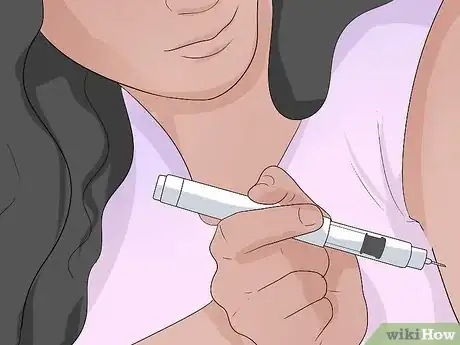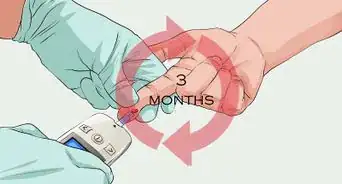This article was medically reviewed by Erik Kramer, DO, MPH. Dr. Erik Kramer is a Board-Certified Primary Care Physician at the University of Colorado. With over 15 years of experience, his clinical interests include obesity and weight management, diabetes care, and preventive care, as well as embracing a holistic approach to primary care. He received his Doctorate in Osteopathic Medicine (D.O.) from the Touro University Nevada College of Osteopathic Medicine and completed his residency at Central Maine Medical Center. Dr. Kramer is a Diplomate of the American Board of Obesity Medicine.
There are 28 references cited in this article, which can be found at the bottom of the page.
This article has been viewed 60,817 times.
Diabetes is a condition that causes your blood sugar, or blood glucose, levels to be too high.[1] Glucose gets into your cells with the help of a hormone called insulin. There are 2 types of diabetes: type 1, which means your body doesn’t produce insulin;[2] and type 2, which means your body doesn’t make or use insulin well.[3] In addition, some women develop gestational diabetes during pregnancy. Diabetes can cause serious health problems such as heart disease or a stroke if you don’t get it treated.[4] But by detecting the symptoms of diabetes, you can get a diagnosis and manage the disease.
Steps
Identifying the Signs of Diabetes
-
1Recognize your risk for diabetes. Although doctors are not sure why some people develop diabetes, there are many different factors that can cause or contribute to diabetes. Being aware of your potential risk for diabetes helps you recognize the signs and can ensure you get a timely diagnosis and treatment. The following factors may increase your risk of type 1, type 2, or gestational diabetes:[5]
- Family history.
- Environmental factors, such as exposure to viral illness.
- The presence of autoantibodies in the system, usually after a viral syndrome when the person is young.
- Dietary factors, such as low vitamin D consumption or exposure to cow’s milk or cereals before the age of 4 months.
- Geography. Countries such as Finland and Sweden have higher rates of type 1 diabetes.
- Weight. The more fat cells you have, the more resistant to insulin they become.
- Sedentary lifestyle or inactivity. Exercising helps control weight and insulin production.
- Race. Certain groups, such as Hispanics and African Americans, are more prone to diabetes.
- Age. Your risk increases as you get older.
- Polycystic ovary syndrome.
- High blood pressure.
- Abnormal cholesterol and triglyceride levels.
- Metabolic syndrome.
- Gestational diabetes and giving birth to a baby over 9 pounds (4.1 kg) can also increase your risk for type 2 diabetes.
-
2Be aware of what doesn’t cause diabetes. Diabetes is a condition related to blood sugar, so some people might think it’s related to eating sugar. Eating sugar doesn’t cause diabetes, but if you are overweight then you can develop peripheral resistance to sugar. Therefore, you have to cut down on the amount of refined sugars that you consume.[6]Advertisement
-
3Watch for possible symptoms. Many symptoms of diabetes may not seem serious and aren’t necessarily specific to the disease, so it’s important to watch your bodily functions to detect potential signs.[7] Identifying possible symptoms of diabetes can help you get a timely diagnosis and treatment. Symptoms of diabetes can include:[8]
- Increased thirst
- Increased hunger, especially after eating
- Dry mouth
- Frequent urination (sometimes more often at night)
- Unexplained weight loss
- Weakness or feeling tired
- Blurred vision
- Numbness or tingling in the hands and feet
- Cuts and sores that heal slowly
- Itchy and dry skin, generally in the vaginal or groin region
- Frequent yeast infections
- Frequent infections of the skin and gums
-
4Keep track of possible symptoms. If you notice any of the signs of diabetes and are concerned they are related to the disease, pay close attention to your body. Note the symptoms you have and how frequently they occur in a notebook or on a piece of paper. These notes may come in handy if you have to see a doctor.[9]
- Watch every bodily function that may be related to diabetes, including how you feel after you eat, if you’re thirsty more often, if you urinate more often, and how quickly you heal from cuts or sores.
- Write down the specific symptoms, how often they occur, and what makes them better or worse.[10]
- Make note of any feelings you experience that aren’t necessarily related to diabetes.
-
5Ask your significant other if they have noticed symptoms. In some cases, your partner, spouse, or another loved one may have noticed symptoms of diabetes that you overlooked. Talk to them about any symptoms you’ve noticed and see if they have made similar observations or any others that might indicate diabetes.
- Tell your loved one what the different symptoms of diabetes are so that they can tell you if they have seen any changes in you or your bodily functions.
Getting a Diagnosis and Treatment
-
1See your doctor if you notice symptoms of diabetes. If you detect any of the signs or symptoms of diabetes, schedule an appointment to see you doctor as soon as possible. Getting a timely diagnosis and treatment from your doctor can help you avoid serious and life-threatening complications.[11]
- Tell your doctor any symptoms you’ve experienced and for how long. Consider using the notes you made as a reference during your exam.[12]
- Make sure your doctor is aware of any risk factors you have, including a family history of diabetes.[13]
- Ask your doctor any questions you may have about diabetes or its treatment.[14] Considering writing down questions before your appointment so that you don’t forget to ask during the appointment.
-
2Get a definitive diagnosis. If your doctor suspects that you have diabetes, they will order additional testing. There are different types of tests to diagnose types 1 and 2 diabetes as well as gestational diabetes. The following tests are used to diagnose diabetes:[15]
- A1c blood test, which is also known as a glycated hemoglobin test.[16] This test shows your average blood sugar level for the past 2 to 3 months by showing how much blood sugar is attached to your hemoglobin. A level of 6.5 is considered diabetic.[17]
- Random blood sugar test, which examines your blood sugar at an unspecified time. A level of 200 milligrams per deciliter indicates diabetes.[18]
- Fasting blood sugar test, which is conducted after an overnight fast. If your blood sugar level is 126 milligrams per deciliter, it’s considered diabetic.[19]
- Oral glucose tolerance test, which requires overnight fasting and then drinking a sugary liquid the next morning. After this, your blood sugar levels will be tested over the next 2 hours. A reading of more than 200 milligrams per deciliter is considered diabetic.[20]
- Initial glucose challenge test and follow-up glucose testing analyze the blood of pregnant women who have fasted and then consumed a sugary liquid. This usually occurs at 24–28 weeks of gestation. If your blood sugar level readings are high for 2 of 3 readings, you’ll be diagnosed with gestational diabetes.[21]
-
3Learn about prediabetes. In some cases, your doctor may notice that your tests have elevated blood sugar levels that don’t qualify for a diabetes diagnosis. This can indicate prediabetes, which means you could develop diabetes. However, prediabetes is also a potentially reversible condition.[22] Test result levels for prediabetes are:[23]
- 5.7–6.4% on the A1c test
- 100–125 milligram per deciliter for the fasting blood sugar test
- 140–199 milligram per deciliter for the oral glucose tolerance test
-
4Receive treatment for diabetes. Depending on the severity of your diabetes, your doctor will likely prescribe different treatments to manage the condition. From insulin injections to healthy eating, following your doctor’s treatment plan is important to manage diabetes and minimize your risk of complications. Medical treatments for diabetes you may receive are:[24]
- Regular monitoring of your blood sugar at home and by your doctor
- Insulin therapy, including daily injections or an insulin pump
- Oral medication, such as metformin to stimulate your pancreas to produce more insulin (if you have type 2 diabetes)
- Physical activity, which may consist of 150 minutes of moderate-intensity activity per week
- A healthy diet, which may mean limiting calories to 1,800–2,000 a day and incorporating more fruits, vegetables, and lean meats and fish
- Controlling blood pressure and cholesterol
- Surgery, such as a pancreas transplant for serious cases
- Bariatric surgery, which is a good option for those with a high BMI and comorbid conditions such as hypertension, sleep apnea, elevated cholesterol, fatty liver disease, and others. The weight loss that follows bariatric surgery may cause type 2 diabetes to go into remission.[25]
- Islet cell transplantation is an experimental treatment for type 1 diabetes in which healthy cells from a donor pancreas are transferred to the patient[26]
-
5Manage diabetes through lifestyle changes. In addition to any medical treatments for diabetes, your doctor will likely suggest helping to manage the disease by changing your lifestyle habits. Lifestyle changes can also help treat prediabetes and may prevent it from developing into type 2 diabetes.[27] Some lifestyle changes your doctor may suggest to help manage diabetes and prediabetes are:
- Eating a balanced and healthy diet[28]
- Getting at least 150 minutes of exercise per week[29]
- Losing weight[30] Losing just 7% of your body weight can significantly reduce your risk of diabetes.[31]
- Caring for your feet by checking them for injuries daily, keeping them clean, dry, and soft, and wearing breathable shoes and socks[32]
- Caring for your oral health[33]
- Limiting or avoiding tobacco and alcohol[34]
- Reducing stress[35]
References
- ↑ https://www.cdc.gov/diabetes/basics/diabetes.html
- ↑ https://www.cdc.gov/diabetes/basics/what-is-type-1-diabetes.html
- ↑ https://www.niddk.nih.gov/health-information/diabetes/overview/what-is-diabetes/type-2-diabetes
- ↑ https://www.nlm.nih.gov/medlineplus/diabetes.html
- ↑ https://www.cdc.gov/diabetes/basics/risk-factors.html
- ↑ https://my.clevelandclinic.org/health/diseases_conditions/hic_Diabetes_Basics
- ↑ https://my.clevelandclinic.org/health/diseases_conditions/hic_Diabetes_Basics
- ↑ https://my.clevelandclinic.org/health/diseases_conditions/hic_Diabetes_Basics
- ↑ https://www.heart.org/en/health-topics/diabetes/symptoms-diagnosis--monitoring-of-diabetes
- ↑ https://www.cdc.gov/diabetes/library/spotlights/journalinghealth.html
- ↑ https://www.cdc.gov/diabetes/managing/care-schedule.html
- ↑ http://www.mayoclinic.org/diseases-conditions/diabetes/basics/preparing-for-your-appointment/con-20033091
- ↑ https://www.heart.org/en/health-topics/diabetes/understand-your-risk-for-diabetes
- ↑ https://www.cdc.gov/diabetes/managing/5-questions-health-care.html
- ↑ https://www.diabetes.org/diabetes/a1c/diagnosis
- ↑ https://my.clevelandclinic.org/health/diseases_conditions/hic_Diabetes_Basics
- ↑ https://www.niddk.nih.gov/health-information/diagnostic-tests/a1c-test
- ↑ https://www.cdc.gov/diabetes/basics/getting-tested.html
- ↑ https://www.cdc.gov/diabetes/basics/getting-tested.html
- ↑ https://medlineplus.gov/ency/article/003466.htm
- ↑ https://medlineplus.gov/ency/article/007562.htm
- ↑ https://www.cdc.gov/diabetes/basics/prediabetes.html
- ↑ http://www.diabetes.org/diabetes-basics/diagnosis/
- ↑ https://www.niddk.nih.gov/health-information/diabetes/overview/insulin-medicines-treatments
- ↑ https://asmbs.org/patients/surgery-for-diabetes
- ↑ https://www.nlm.nih.gov/medlineplus/isletcelltransplantation.html
- ↑ https://my.clevelandclinic.org/health/diseases/21498-prediabetes
- ↑ https://my.clevelandclinic.org/health/diseases_conditions/hic_Diabetes_Basics/endo_education
- ↑ https://my.clevelandclinic.org/health/diseases_conditions/hic_Diabetes_Basics/endo_education
- ↑ https://my.clevelandclinic.org/health/diseases_conditions/hic_Diabetes_Basics/endo_education
- ↑ https://www.niddk.nih.gov/health-information/diabetes/overview/preventing-type-2-diabetes
- ↑ https://my.clevelandclinic.org/health/diseases_conditions/hic_Diabetes_Basics/endo_education
- ↑ https://www.cdc.gov/diabetes/managing/diabetes-oral-health.html
- ↑ https://www.cdc.gov/diabetes/ndep/pdfs/82-balanced-life-ndep-123-tobacco-alcohol-use-508.pdf
- ↑ https://my.clevelandclinic.org/health/articles/14891-diabetes-stress--depression
About This Article
To detect diabetes symptoms, monitor yourself for symptoms like increased thirst and hunger, dry mouth, frequent urination, unexplained weight loss, weakness, lethargy, blurred vision, and numbness or tingling in the hands and feet. If you notice these symptoms, keep track of when and how often you experience them. However, keep in mind that these things can also be symptoms of other issues, so it's important that you see your doctor to get an accurate diagnosis. Your doctor will be able to run tests to determine whether or not you have diabetes and then recommend the best treatment plan if you do. For tips from our Medical co-author, like how to recognize your risk for diabetes, keep reading.






































































Medical Disclaimer
The content of this article is not intended to be a substitute for professional medical advice, examination, diagnosis, or treatment. You should always contact your doctor or other qualified healthcare professional before starting, changing, or stopping any kind of health treatment.
Read More...